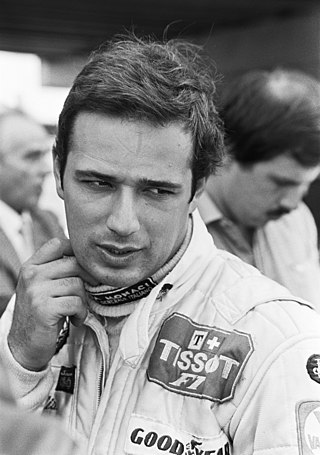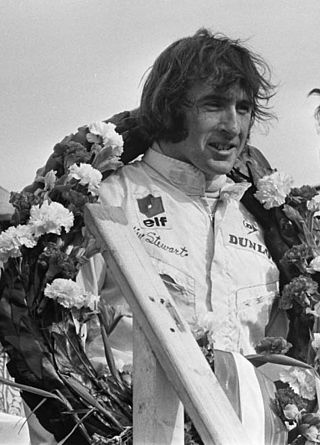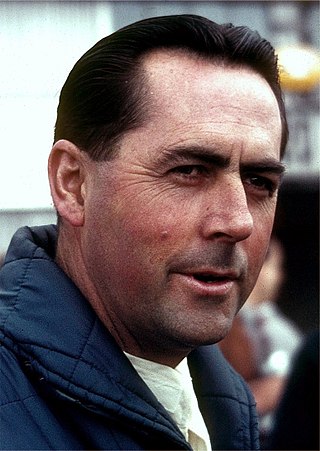Motor Racing Developments Ltd., commonly known as Brabham, was a British racing car manufacturer and Formula One racing team. It was founded in 1960 by the Australian driver Jack Brabham and the British-Australian designer Ron Tauranac. The team had a successful thirty-year history, winning four FIA Formula One Drivers' and two Constructors' World Championships, starting with two successive wins in 1966 and 1967. Jack Brabham's 1966 Drivers' Championship remains the only such achievement using a car bearing the driver's own name.

Nelson Piquet Souto Maior is a Brazilian retired racing driver and businessman who won the World Drivers' Championship three times in the years 1981, 1983 and 1987.

Elio de Angelis was an Italian racing driver who participated in Formula One between 1979 and 1986, racing for the Shadow, Lotus and Brabham teams. He was killed in an accident while testing the Brabham BT55 at the Paul Ricard circuit, near the commune of Le Castellet, France, in 1986. De Angelis was a very competitive and highly popular presence in Formula One during the 1980s, and is sometimes referred to as Formula One's "last gentleman player".

The 1960 Italian Grand Prix was a Formula One motor race held at Monza on 4 September 1960. It was race 9 of 10 in the 1960 World Championship of Drivers and race 8 of 9 in the 1960 International Cup for Formula One Manufacturers. The race was won by American driver Phil Hill driving a Ferrari 246 F1.

The 1969 Formula One season was the 23rd season of the FIA's Formula One motor racing. It featured the 20th World Championship of Drivers, the 12th International Cup for F1 Manufacturers and four non-championship races open to Formula One cars. The World Championship was contested over eleven races between 1 March and 19 October 1969.

The 1965 Formula One season was the 19th season of FIA Formula One racing. It featured the 16th World Championship of Drivers, the 8th International Cup for F1 Manufacturers, and seven non-championship races open to Formula One cars. The World Championship was contested over ten races between 1 January and 24 October 1965.

The 1964 Formula One season was the 18th season of FIA Formula One motor racing. It featured the 15th World Championship of Drivers, the 7th International Cup for F1 Manufacturers, and eight non-championship races open to Formula One cars. The World Championship was contested over ten races between 10 May and 25 October 1964.

The 1963 Formula One season was the 17th season of FIA Formula One motor racing. It featured the 14th World Championship of Drivers, the 6th International Cup for F1 Manufacturers, and numerous non-championship Formula One races. The World Championship was contested over ten races between 26 May and 28 December 1963.

The 1962 Formula One season was the 16th season of FIA Formula One motor racing. It featured the 13th World Championship of Drivers, the 5th International Cup for F1 Manufacturers, and numerous non-championship Formula One races. The World Championship was contested over nine races between 20 May and 29 December 1962.

The 1960 Formula One season was the 14th season of FIA Formula One motor racing. It featured the 11th World Championship of Drivers, the third International Cup for F1 Manufacturers and five non-championship Formula One races. The World Championship was contested over ten races between 7 February and 20 November 1960.

The Swedish Grand Prix was a round of the Formula One World Championship from 1973 to 1978. It took place at the Scandinavian Raceway in Anderstorp, about 65 kilometres (40 mi) from Jönköping, in Småland, Sweden. The first race to hold the title of Grand Prix in Sweden was the Swedish Winter Grand Prix, an ice race similar to races held in Estonia, Finland and Norway. The first Swedish Summer Grand Prix was held in 1933, but was not repeated until 1949.

José Carlos Pace was a racing driver from Brazil. He participated in 73 Formula One World Championship Grands Prix, debuting at the 1972 South African Grand Prix. He won one race, achieved six podiums, and scored a total of 58 championship points. He also secured one pole position.

Giancarlo Baghetti was a Formula One driver who raced for the Ferrari, Automobili Turismo e Sport, BRM, Brabham and Lotus teams.
Neville Lederle was a racing driver from South Africa. He participated in two World Championship Formula One Grands Prix, scoring a single championship point.

Team Rebaque was a Mexican Formula One entrant and constructor, based in Leamington Spa, UK. They participated in 30 Grands Prix, initially entering cars bought from Team Lotus, before finally building a car of their own. The Rebaque HR100 was entered for the team's final three races before the team's closure. The team qualified to race on 19 occasions, and achieved one World Constructors' Championship point with its best finish of sixth at the 1978 German Grand Prix.

The Lotus 49 was a Formula One racing car designed by Colin Chapman and Maurice Philippe for the 1967 F1 season. It was designed around the Cosworth DFV engine that would power most of the Formula One grid through the 1970s. It was one of the first F1 cars to use a stressed member engine combined with a monocoque to reduce weight, with other teams adopting the concept after its success. An iteration of it, the 49B, also pioneered the use of aerofoils to generate downforce.
Rob Walker Racing Team was a privateer team in Formula One during the 1950s and 1960s. Founded by Johnnie Walker heir Rob Walker (1917–2002) in 1953, the team became F1's most successful privateer in history, being the first and only entrant to win a World Championship Formula One Grand Prix without ever building their own car.

The Repco Brabham BT24 was a Formula One racing car design. It was one of three cars used by the Brabham racing team during their championship-winning 1967 Formula One season. Only three BT24 chassis were ever raced.

The Cooper T51 was a Formula One and Formula Two racing car designed by Owen Maddock and built by the Cooper Car Company for the 1959 Formula One season. The T51 earned a significant place in motor racing history when Jack Brabham drove the car to become the first driver to win the World Championship of Drivers with an engine mounted behind them, in 1959. The T51 was raced in several configurations by various entrants until 1963 and in all no less than 38 drivers were entered to drive T51s in Grand Prix races.

The Brabham BT3 is a Formula One racing car. It was the first Formula One design to be produced by Motor Racing Developments for the Brabham Racing Organisation, and debuted at the 1962 German Grand Prix. The Brabham BT3 was the vehicle with which team owner – then two-time World Champion – Jack Brabham, became the first driver ever to score World Championship points in a car bearing his own name, at the 1962 United States Grand Prix. The following year Brabham also became the first driver ever to win a Formula One race at the wheel of an eponymous car, again driving the BT3, at the 1963 Solitude Grand Prix. The BT3 design was modified only slightly to form the Tasman Series-specification Brabham BT4 cars.
















